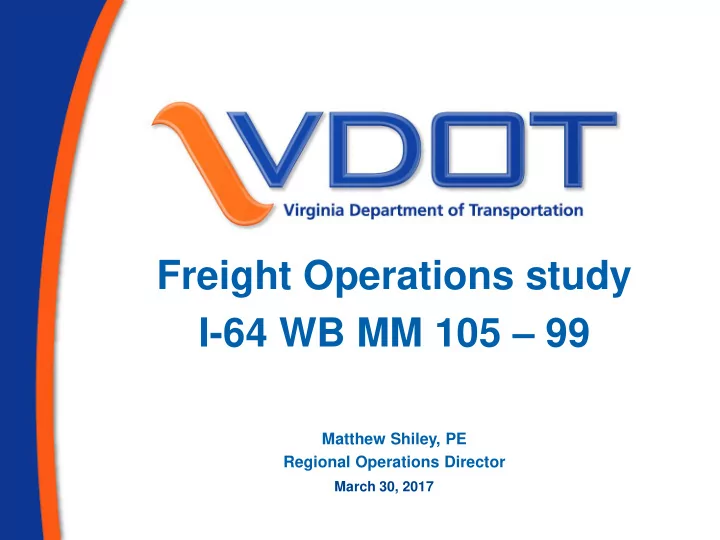

Freight Operations study I-64 WB MM 105 – 99 Matthew Shiley, PE Regional Operations Director March 30, 2017
Operations Problem ➢ I-64 Westbound ▪ From MM 105 to MM 99 ▪ Weekday evening Peak hours ➢ Speed Differentials ▪ Steep grades ▪ Mix of passenger vehicles and freight traffic ➢ Lane Utilization ▪ Driver behavior (lane changing, braking, small gaps) ▪ Existing law for trucks & comb. vehicles traveling below posted speed limit ➢ Congestion ▪ Reduced speeds ▪ Reduced travel time 2
Approach ➢ Operational Analysis (2015-16) ➢ Crashes ➢ Grades ➢ Traffic volume and mix ➢ Speeds ➢ Lane utilization ➢ Truck climbing lane warrants evaluation (AASHTO) ➢ VISSIM Model (2016) ➢ Model exiting traffic conditions ➢ Evaluate potential solutions 3
Findings ➢ Average Daily Traffic(ADT): 18,700 vehicles (14% Trucks) ➢ PM Peak Hour: 5-6 PM (M-F) 1,840 vehicles (9% Trucks) ➢ Posted Speed Limit: 65 MPH ➢ 85 th percentile speed: +71 MPH ➢ MM105.5 to 100.2 ▪ Overall travel speeds decrease as vehicles travel uphill ➢ MM104 (5-6PM) ▪ 73% (1,350) of vehicles are using the inside/left lane ➢ MM 100.2 ▪ 21% of vehicles traveling in the right/outer lane are traveling at speeds lower then 50 MPH 4
Findings ➢ Consistent Pattern observed from data: ➢ Non-Peak period — Truck Volume in left lane is lower than the truck volume in right lane ➢ Peak Period (4:00-6:00 pm)---Truck volume in Left Lane exceeds the Right Lane truck volume ➢ Field Observations during PM peak period: Trucks that move to the left lane generally do so to overtake slow moving Trucks in the right lane 5
Speed Comparison 6
5-Year Crash Analysis ➢ I-64 WB - MM 104 – 99 ▪ 76 total crashes from 2010 – 2014 ▪ 52.05 crashes per 100 Million VMT +2.64% from Culpeper District Average +20.28% from Staunton District Average ▪ No Fatal crashes ▪ 41% (31) Rear-End crashes (highest type) ▪ (7) Non-rear end; attributed to speed differentials ➢ 50% of all crashes Rear-end or speed related 7
AASHTO Climbing Lane for Multi-Lane Highways If ONE of the following principles is satisfied, consideration of a truck climbing lane IS WARRANTED: Critical Length of Grade: Length of grade exceeds the critical length of grade. ✓ Segment meets criteria Service Flow Volume: Service flow volume is greater than 1,000 vehicles per hour per lane(vphpl) but less then 1,700 vphpl. ✓ Segment meets criteria Operational Assessment (Level of Service): Existing level of service exceeds LOS D and would be improved one grade level with the addition of a truck climbing lane. X Segment does not meet criteria 8
Traffic Model Findings ➢ 100% Truck Restriction on Left Lane was modeled ➢ Left Lane impacts: In the higher grades, average speed goes up in the left lane, compared to existing conditions; Speed difference is significant (5% increase), although less volume is processed. ➢ Right Lane impacts: Speed difference is minimal over existing and more volume is processed ➢ Average speed (Trucks & Cars combined) slows down around 3:00 PM and starts increasing around 7:00 PM 9
Potential Solutions and challenges ▪ Interim Solutions: Upgrade existing signs and use Changeable Message Signs (CMS) to alert trucks to use the right lane ▪ Monitor & Evaluate effectiveness Static Signing: Completed 2016 CMS signs activated 3/23/17 (M-F; 3-7:00 PM) TRUCKS BELOW 65MPH USE RIGHT LANE ONLY • CMS sign message at MM 102 & 104 • CMS sign at MM 110 displays travel time to I-81/Staunton 10
Potential Solutions and challenges ➢ Temporary Solution - FHWA Hard Shoulder Running ▪ http://ops.fhwa.dot.gov/publications/fhwahop10023/chap4.htm ▪ Approval must be obtained from FHWA for Hard Shoulder Running ▪ Providing Refuge/Pull-offs for breakdowns needed ▪ The intent is for these facilities to be temporary in nature and not a permanent solution for long-term capacity provision ▪ Requires an ITS system to operate dynamically ➢ Construction of a westbound truck climbing lane. ➢ Funding 11
QUESTIONS? 12
Recommend
More recommend